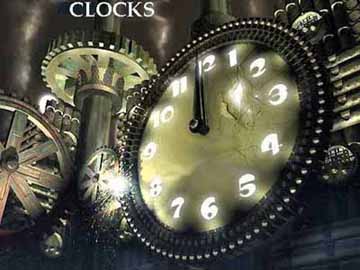
Pre-historic man did not have a need for clocks, but as civilization evolved, that all chnaged. The historical record reveals that approximatley 5000 to 6000 years ago great civilizations in the Middle East and North Africa began to make clocks to augment their calendars. With their attendant bureaucracies, formal religions, and other burgeoning societal activities, these cultures apparently found a need to organize their time more efficiently.
A clock (from the Latin cloca - bell) is an instrument for measuring time and for measuring time intervals of less than a day - as opposed to a calendar. Those used for technical purposes, of very high accuracy, are usually called chronometers. A portable clock is called a watch. The clock in its most common modern form (in use since at least the 14th century) displays the hours, minutes and, sometimes, seconds that pass during a twelve- or twenty-four-hour period.
One of the key drivers of inventing methods of keeping track of time were the farmers needs to determine the best time to plant. Archaeologists have discovered bones with inscriptions that are believed to have been used to track lunar cycles.
The clock is one of the oldest human inventions, requiring a physical process that will proceed at a known rate and a way to gauge how long that process has run. As the seasons and the phases of the moon can be used to measure the passage of longer periods of time, shorter processes had to be used to measure off hours and minutes.
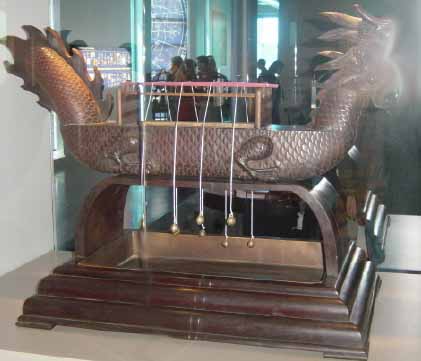
Incense Alarm Clock
Candles and sticks of incense that burn down at approximate predictable speeds were also used as to estimate the passage of time. The image above of an ancient Chinese dragon shaped device was constructed with a sequence of bells tied to a horizontally mounted burning incense. When the burning incense burnt and broke the threads, the bells fell down at preset interval to give an alarm.
An hourglass filled with fine sand, poured through a tiny hole,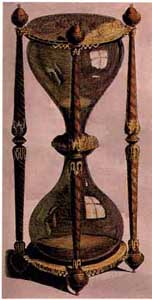
at a constant rate, indicated a predetermined passage of time.
An hour glass is basically 2 bubbles of glass with a narrow middle; wood is used to close off the sand. The sand is measured and sealed and the hour glass is turned over and over. This type of clock was the first one to not be dependent on the weather. It's used for short periods of time such as speeches, sermons, watch duty, cooking, and at sea to calculate one's position.
To calculate the speed at sea, one would throw a piece of wood overboard tied with a knotted rope. When a knot ran through one's fingers in 1/2 a minute measured by the hour glass, it indicated that the vessel was going at the speed of 1 nautical mile an hour. The knots were very wide apart and one just counted the knots. Hence the phrase "knots an hour".
The center of the hour glass would get clogged. Course sand wore away at the center and made the opening wider. An hour glass had to be on a flat surface in order to work properly.

Sundials were another early method for marking time.
The sundial, which measures the time of day by the direction of shadows cast by the sun, was widely known in ancient times.
The Sumerians used sundials. They divided the day into 12 parts and each part was about 2 hours long. They measured the length of shadows to determine how much time had passed. No one is really sure why the Sumerians kept track of time; maybe it was for religious purposes. Sundials were dependent on the weather; it would be useless on a cloudy day and the winter and summer shadows would not correspond with the markings. In order for the sundial to work correctly, it had to be positioned correctly.
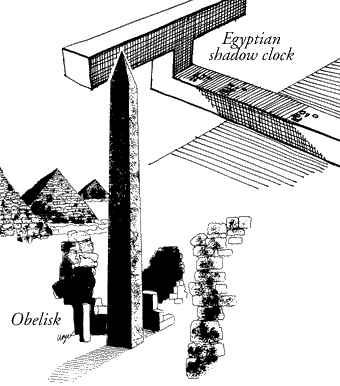
The Egyptians, by 2100 BC, had invented a means to divide the day into 24 hours using sundials or shadow clocks to measure the time of day. The Sundial indicates the time of day by the positioning of the shadow of some object on which the sun's rays fall. The shadow clock consists of a straight base with a raised crosspiece at one end. A scale with time divisions is inscribed on the base. The clock is set east-west and is reversed at midday.
The Egyptians also divided the day into 12 parts as well. They used huge granite columns called Cleopatra Needles, a trio of obelisks, to keep track of time periods. They had 12 marks on the ground that equalled 12 parts of the day. When the sun touched the top, a shadow was created and the length and position of the shadow told the Egyptians how much daylight remained. They invented a portable piece called a sundial. It contains 3 parts: a circular dial, a needle and a style (gnomon) to keep the needle in place. Cleopatra's needles were inconvient and impractical for the average person.
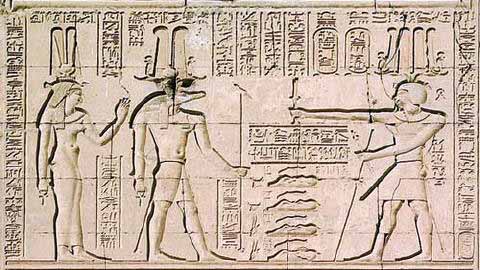
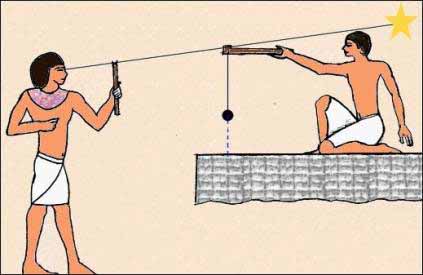
The 'merkhet', the oldest known astronomical tool, was an Egyptian development of around 600�B.C. A pair of merkhets were used to establish a north-south line by lining them up with the Pole Star. They could then be used to mark off nighttime hours by determining when certain other stars crossed the meridian. The Merkhet, known as the "instrument of knowing" was a sighting tool made from the central rib of a palm leaf and was similar in function to an astrolobe. The merkhet was used for aligning the foundations of the pyramids and sun temples with the cardinal points, and was usually correct to within less than half a degree.
The Romans divided time into night and day. According to the writer Pliny, criers announced the rising/setting of the sun. In 30 B.C, they stole Cleopatra's Needle but were unable to adapt. Al-Battani realized that the gnomon (pointer) had to point towards the North Star and the length and size of the gnomon varied with the distance from the equator.
In the quest for more year-round accuracy, sundials evolved from flat horizontal or vertical plates to more elaborate forms. One version was the hemispherical dial, a bowl-shaped depression cut into a block of stone, carrying a central vertical gnomon and scribed with sets of hour lines for different seasons. The hemicycle, said to have been invented about 300�B.C., removed the useless half of the hemisphere to give an appearance of a half-bowl cut into the edge of a squared block. By 30�B.C., Vitruvius could describe 13 different sundial styles in use in Greece, Asia Minor, and Italy.
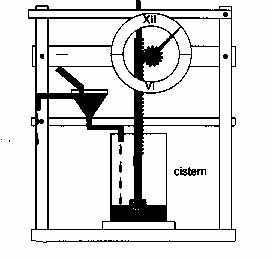
Water clocks were among the earliest timekeepers that didn't depend on the observation of celestial bodies. Water clocks were used in ancient Babylon, Mesopotami, China, Korea, Egypt, Greece, India, Arabia, Muslim and civilizations.
One of the oldest water clocks was found in the tomb of Amenhotep I, buried around 1500 B.C.
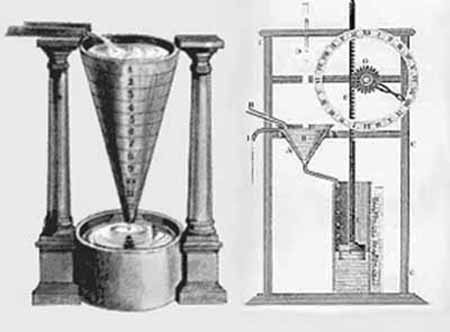
Later they were named clepsydras ('water thief') by the Greeks, who began using them about 325 B.C. These were stone vessels with sloping sides that allowed water to drip at a nearly constant rate from a small hole near the bottom.
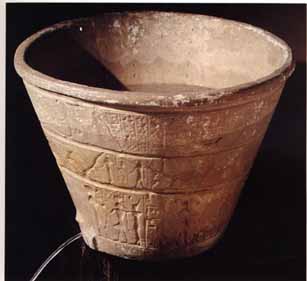
Other Egyptian clepsydras were cylindrical or bowl-shaped containers designed to slowly fill with water coming in at a constant rate. Markings on the inside surfaces measured the passage of "hours" as the water level reached them. These clocks were used to determine hours at night, but may have been used in daylight as well. Another version consisted of a metal bowl with a hole in the bottom; when placed in a container of water the bowl would fill and sink in a certain time. These were still in use in North Africa this century. The need to track night hours lead to the invention of the water clock by 1500 BC, the Egyptians. This clock uses the steady dripping of water from a vessel to drive a mechanical device that tells the time. It was basically a bucket of water with a hole in the bottom. A water clock showed the passage of time but it didn't keep exact hours in a day. Egyptians were the people most likely to have invented them but the Greeks had the most advanced ones.
The historian Vitruvius reported that the ancient Egyptians used a clepsydra, a time mechanism using flowing water. Herodotus had mentioned an ancient Egyptian time-keeping device that was based on mercury. By the 9th century AD a mechanical timekeeper had been developed that lacked only an escapement mechanism.
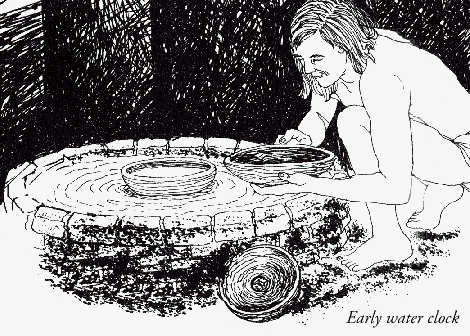
In 250 B.C, Archimedes built a more elaborate water clock; he added gears and showed the planets and moon orbiting.
In order for a water clock to work properly, someone had to keep an eye on it; to make sure that no pebbles were in the bowl to increase talking time. These clocks were never exact; each clock had its own pace. And they couldn't be used in winter.
These clocks were used for nearly 3,000 years and grew more and more sophisticated. Water clocks were designed with ringing bells, moving puppets and mechanical singing birds.
More elaborate and impressive mechanized water clocks were developed between 100 B.C. and 500 A.D. by Greek and Roman horologists and astronomers. The added complexity was aimed at making the flow more constant by regulating the pressure, and at providing fancier displays of the passage of time. Some water clocks rang bells and gongs, others opened doors and windows to show little figures of people, or moved pointers, dials, and astrological models of the universe.
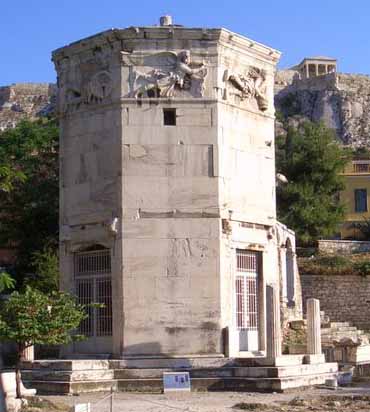
Greek astronomer, Andronikos, supervised the construction of the Tower of the Winds in Athens in the 1st century B.C. This octagonal structure showed scholars and marketplace shoppers both sundials and mechanical hour indicators. It featured a 24-hour mechanized clepsydra and indicators for the eight winds from which the tower got its name, and it displayed the seasons of the year and astrological dates and periods. The Romans also developed mechanized clepsydras, though their complexity accomplished little improvement over simpler methods for determining the passage of time.
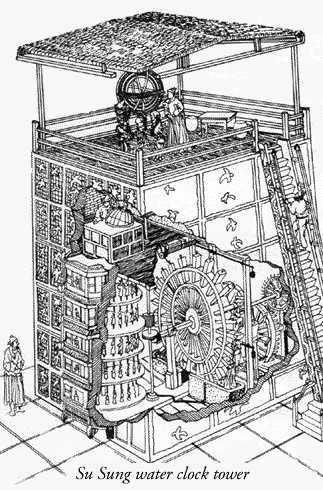
In the Far East, mechanized astronomical/astrological clock-making developed from 200 to 1300 A.D. Third-century Chinese clepsydras drove various mechanisms that illustrated astronomical phenomena. One of the most elaborate clock towers was built by Su Sung and his associates in 1088 A.D. Su Sung's mechanism incorporated a water-driven escapement invented about 725 A.D. The Su Sung clock tower, over 30 feet tall, possessed a bronze power-driven armillary sphere for observations, an automatically rotating celestial globe, and five front panels with doors that permitted the viewing of changing mannikins which rang bells or gongs, and held tablets indicating the hour or other special times of the day.
The first clock used gravity pulled weights which moved gears, which moved the hands of the clock. The problem with this device was someone had to constantly reset the weights.
14th century clocks show the four key elements common to all clocks in subsequent centuries, at least up to the digital age:
- the power, supplied by a falling weight, later by a coiled spring
- the escapement, a periodic repetitive action that allows the power to escape in small bursts rather than drain away all at once
- the going train, a set of interlocking gear wheels that controls the speed of rotation of the wheels connected between the power supply and the indicators
- indicators, such as dials, hands, and bells
No clocks survive from medieval Europe but various mentions in church records reveal some of the early history of the clock.
Medieval religious institutions required clocks to measure and indicate the passing of time because, for many centuries, daily prayer and work schedules had to be strictly regulated. This was done by various types of time-telling and recording devices, such as water clocks, sundials and marked candles, probably used in combination. Important times and durations were broadcast by bells, rung either by hand or by some mechanical device such as a falling weight or rotating beater.
The word 'horologia' (from the Greek hora, hour, and legein, to tell) was used to describe all these devices but the use of this word (still used in several romance languages) for all timekeepers conceals from us the true nature of the mechanisms. For example, there is a record that in 1176 Sens Cathedral installed a 'horologe' but the mechanism used is unknown.
In 1198, during a fire at the abbey of St Edmundsbury (now Bury St Edmunds) the monks 'ran to the clock' to fetch water, indicating that their water clock had a reservoir large enough to help extinguish the occasional fire.These early clocks may not have used hands or dials but �told� the time with audible signals.
The word 'clock' (from the Latin word for "bell") which gradually supersedes 'horologe' suggests that it was the sound of bells which also characterized the prototype mechanical clocks that appeared during the 13th century.
Between 1280 and 1320 there is an increase in the number of references to clocks and horologes in church records, and this probably indicates that a new type of clock mechanism had been devised. Existing clock mechanisms that used water power were being adapted to take the driving power from falling weights. This power was controlled by some form of oscillating mechanism, probably derived from existing bell-ringing or alarm devices. This controlled release of power - the escapement - marks the beginning of the true mechanical clock.
These mechanical clocks were intended for two main purposes: for signalling and notification (e.g. the timing of services and public events), and for modelling the solar system. The former purpose is administrative, the latter arises naturally given the scholarly interest in astronomy, science, astrology, and how these subjects integrated with the religious philosopy of the time.
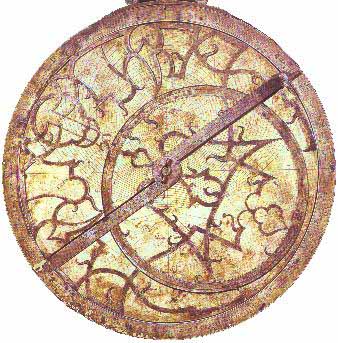
Astrolabe
The astrolabe was used both by astronomers and astrologers, and it was natural to apply a clockwork drive to the rotating plate to produce a working model of the solar system.
Simple clocks intended mainly for notification were installed in towers, and did not always require dials or hands. They would have announced the canonical hours or intervals between set times of prayer. Canonical hours varied in length as the times of sunrise and sunset shifted.
The more sophisticated astronomical clocks would have had moving dials or hands, and would have shown the time in various time systems, including Italian hours, canonical hours, and time as measured by astronomers at the time. Both styles of clock started acquiring extravagant features such as automata.
In 1283 a large clock was installed at Dunstable Priory; its location above the rood screen suggests that it was not a water clock.
In 1292, Canterbury Cathedral installed a 'great horloge'. Over the next 30 years there are brief mentions of clocks at a number of ecclesiastical institutions in England, Italy, and France.
In 1322 a new clock was installed in Norwich, an expensive replacement for an earlier clock installed in 1273. This had a large (2 metre) astronomical dial with automata and bells. The costs of the installation included the full-time employment of two technicians for two years.
The first major advance in clock construction occurred in Europe during the 14th century. It was found that the speed of a falling weight could be controlled by using a oscillating horizontal bar attached to a vertical spindle with two protrusions on it which acted like escapements, (cliff like ridges). When the protrusions meshed with a tooth of a gear driven by the weight, it momentarily stopped the revolving wheel and weight. These oldest type of mechanical clocks can still be seen in France and England.
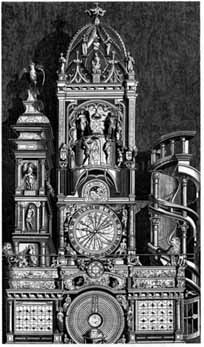
Strasbourg Cathedral
View my trip there in 2005
The Strasbourg Cathedral was the first clock tower built (1352-54) and still works today.
As Europe grew, each town had to find a way to tell time; there was an emphasis on productivity and work.
14th Century
Near the end of the 14th century, the spring had begun to replace the weight in some clocks. This advancement allowed for clocks which could be carried. One problem with a spring clock is that the escapement mechanism must always be operated with a constant force. The problem was that as the spring unwound, it lost power. To solve this, the stackfreed was introduced. This is an extra spring that works against the motion when the watch is fully wound.
15th Century
Spring-driven clocks were developed during the 15th century, and this gave the clockmakers many new problems to solve, such as how to compensate for the changing power supplied as the spring unwound.
The first record of a minute hand on a clock is 1475, in the Almanus Manuscript of Brother Paul.
16th Century
In 1504 the first portable time piece was invented in Nuremberg, Germany by Peter Henlein. Replacing the heavy drive weights permitted smaller (and portable) clocks and watches. Although they slowed down as the mainspring unwound, they were popular among wealthy individuals due to their size and the fact that they could be put on a shelf or table instead of hanging from the wall. These advances in design were precursors to truly accurate timekeeping.
In 1577 the minute hand was invented by Jost Burgi for Tycho Brahe; he was an astronomer who needed accurate clocks to track stars.
During the 15th and 16th centuries, clockmaking flourished, particularly in the metalworking towns of Nuremberg and Augsburg, and, in France, Blois. Some of the more basic table clocks have only one time-keeping hand, with the dial between the hour markers being divided into four equal parts making the clocks readable to the nearest 15 minutes. Other clocks were exhibitions of craftsmanship and skill, incorporating astronomical indicators and musical movements.
The cross-beat escapement was developed in 1585 by Jobst Burgi, who also developed the remontoire. Burgi's accurate clocks helped Tycho Brahe and Johannes Kepler to observe astronomical events with much greater precision than before.The first record of a second hand on a clock is about 1560, on a clock now in the Fremersdorf collection.
However, this clock could not have been accurate, and the second hand was probably for indicating that the clock was working.The next development in accuracy occurred after 1657 with the invention of the pendulum clock.
17th Century
By 1656, the pendulum was incorporated into clocks, which lead to better paced and more accurate clocks. Although fairly accurate, clocks accuracy was dramatically improved by the introduction of the pendulum. Galileo had the idea to use a swinging bob to propel the motion of a time telling device earlier in the 17th century. Although Galileo Galilei, sometimes credited with inventing the pendulum, studied its motion as early as 1582, Galileo's design for a clock was not built before his death.
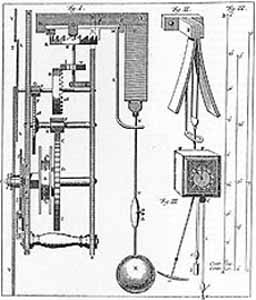
Christiaan Huygens' pendulum clock was regulated by a mechanism with a "natural" period of oscillation. Huygens' pendulum clock had an error of less than 1 minute a day, the first time such accuracy had been achieved. His later refinements reduced his clock's errors to less than 10 seconds a day.
Around 1675 Huygens developed the balance wheel and spring assembly, still found in some of today's wrist watches. This improvement allowed 17th century watches to keep time to 10 minutes a day. And in London in 1671 William Clement began building clocks with the new "anchor" or "recoil" escapement, a substantial improvement over the verge because it interferes less with the motion of the pendulum.
In 1670, the English clockmaker William Clement created the anchor escapement, an improvement over Huygens' crown escapement. Within just one generation, minute hands and then second hands were added.
A major stimulus to improving the accuracy and reliability of clocks was the importance of precise time-keeping for navigation. The position of a ship at sea could be determined with reasonable accuracy if a navigator could refer to a clock that lost or gained less than about 10 seconds per day. Many European governments offered a large prize for anyone that could determine longitude accurately.
Christiaan Huygens, however, is usually credited as the inventor. He determined the mathematical formula that related pendulum length to time (99.38 cm or 39.13 inches for the one second movement) and had the first pendulum-driven clock made.
The pendulums swinging ensures that the protrusions move the gears wheels tooth by tooth while the motion of the protrusions keeps the pendulum moving. It was improved further by the Englishmen Robert Hooke who invented the anchor or recoil escapement.
During the 16th and 17th centuries the need for accurate clocks while sailing across the oceans arose. While springs made clocks portable, they were not accurate for long periods. Hooke realized that a spring would not be affected by the ship's motion as a pendulum would, but the available mainspring devices were not accurate enough for long periods of time until 1675, when the balance wheel, a very thin spiral hairspring (separate from the mainspring) whose inner end was secured to the spindle of a rotatable balance and whose outer end was fixed to the case of the timepiece. The spring stored or released energy during the rotation of the balance. John Harrison's chronometer no. 4, was in error by only 54 seconds after a sea voyage of 156 days.
The balance wheel, hairspring, and mainspring, together with the anchor escapement, or improved escapements, still make up the basics of even todays modern watches. Introduction of jewels as bearings have further improved on this basic system.
This improved the functioning of the gear train. Infact, this method is still used today. The greatest benefit of this method was that it allowed for very long pendulums with a swing of one second. The out growth of this invention was the walled pendulum clock where the weights and pendulum are completely enclosed in a case. Of course, most people are very familiar with these clocks with the most common being the 'Grandfather Clock'.

The reward was eventually claimed in 1761 by John Harrison, who dedicated his life to improving the accuracy of his clocks. His H5 clock is reported to have lost less than 5 seconds over 10 days.
The excitement over the pendulum clock had attracted the attention of designers resulting in a proliferation of clock forms. Notably, the longcase clock (also known as the grandfather clock) was created to house the pendulum and works. The English clockmaker William Clement is also credited with developing this form in 1670 or 1671. It was also at this time that clock cases began to be made of wood and clock faces to utilize enamel as well as hand-painted ceramics.
18th Century
In 1721 George Graham improved the pendulum clock's accuracy to 1 second a day by compensating for changes in the pendulum's length due to temperature variations. John Harrison, a carpenter and self-taught clock-maker, refined Graham's temperature compensation techniques and added new methods of reducing friction.
By 1761 he had built a marine chronometer with a spring and balance wheel escapement that won the British government's 1714 prize (of over $2,000,000 in today's currency) offered for a means of determining longitude to within one-half degree after a voyage to the West Indies. It kept time on board a rolling ship to about one-fifth of a second a day, nearly as well as a pendulum clock could do on land, and 10 times better than required.
On November 17, 1797, Eli Terry received his first patent for a clock. Terry is known as the founder of the American clock-making industry.
19th Century
Alexander Bain, Scottish clockmaker, patented the electric clock in 1840. The electric clock's mainspring is wound either with an electric motor or with an electro-magnet and armature. In 1841, he first patented the electromagnetic pendulum.
Over the next century refinements led in 1889 to Siegmund Riefler's clock with a nearly free pendulum, which attained an accuracy of a hundredth of a second a day and became the standard in many astronomical observatories. A true free-pendulum principle was introduced by R. J. Rudd about 1898, stimulating development of several free-pendulum clocks.
20th Century
One of the most famous, the W. H. Shortt clock, was demonstrated in 1921. The Shortt clock almost immediately replaced Riefler's clock as a supreme timekeeper in many observatories. This clock consists of two pendulums, one a slave and the other a master. The slave pendulum gives the master pendulum the gentle pushes needed to maintain its motion, and also drives the clock's hands. This allows the master pendulum to remain free from mechanical tasks that would disturb its regularity.
Watches run by small batteries were introduced in the 1950s. The balance of such an electric watch is kept in motion electromagnetically by a coil that is energized by an electronic circuit.
The development of electronics in the twentieth century led to clocks with no clockwork parts at all. Time in these cases is measured in several ways, such as by the vibration of a tuning fork, the behavior of quartz crystals, the decay of radioactive elements or resonance of polycarbonates. Even mechanical clocks have since come to be largely powered by batteries, removing the need for winding.
Types of Clocks
Analog, Digital, Auditory, Quartz, Binary, Astronomical, Cartel, Cuckoo, Chiming, Floral, Other
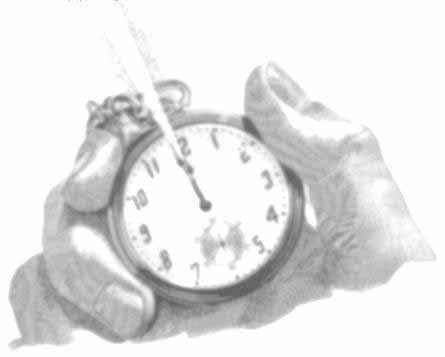
The 12-hour clock is a timekeeping convention in which the 24 hours of the day are divided into two periods called ante meridiem (a.m., from Latin, literally "before midday") and post meridiem (p.m., "after midday"). Each period consists of 12 hours numbered 12 (acting as a zero), 1, 2, 3, 4, 5, 6, 7, 8, 9, 10, 11. The a.m. period runs from midnight to noon, while the p.m. period runs from noon to midnight. The most common convention is to assign 12 a.m. to midnight (at the beginning of the day) and 12 p.m. to noon, defining both half days to have a closed (inclusive) beginning and open (exclusive) end. 12 noon and 12 midnight can more clearly express these times (except that for midnight one may need to also specify whether it is the midnight at the beginning or the end of the day in question).
The 12-hour clock originated in Egypt. However, the lengths of their hours varied seasonally, always with 12 hours from sunrise to sunset and 12 hours from sunset to sunrise, the hour beginning and ending each half-day (four hours each day) being a twilight hour. An Egyptian sundial for daylight use and an Egyptian water clock for nighttime use found in the tomb of Pharaoh Amenhotep I, both dating to c. 1500 BC, divided these periods into 12 hours each. The Romans also used a 12-hour clock: the day was divided into 12 equal hours (of, thus, varying length throughout the year) and the night was divided into three watches. The Romans numbered the morning hours originally in reverse. For example, "3 a.m." or "3 hours ante meridiem" meant "three hours before noon", compared to the modern meaning of "three hours after midnight".
Clocks in the News
Most Accurate Clock Ever: 'Crystal Of Light' Clock Science Daily - February 18, 2008
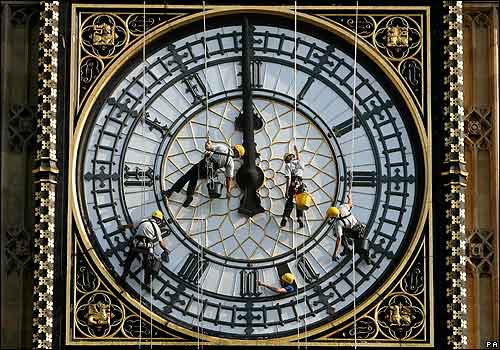
Big Ben silenced for repair work BBC - August 12, 2007
Climate resets 'Doomsday Clock' BBC - January 17, 2007
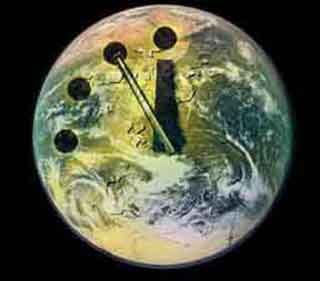
Doomsday Clock
Atomic Time Lords: Atomic ticker clocks up 50 years BBC - June 2, 2005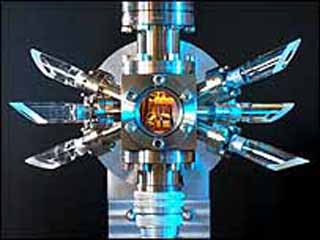
The most accurate clock of all time New Scientist - May 18, 2005
The clock that wakes you when you are ready New Scientist - April 2005
Discovery of an early historic clock dating to 6500 years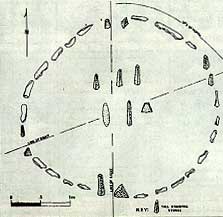
AP - April 10, 2001
- The joint archaeological mission of the University of Dallas made huge discoveries in the area of Nabta 100 km west of Abu Simbel. The discoveries relate to prehistoric times, tools, clay vessels, and skeletons. The area of Nabta is one of the most important areas for archaeological excavation related to prehistoric times. It measures 5,000 square meters and includes the remains of stores, wells and houses. The mission also found tombs where in one of them there were 30 skeletons and some bracelets made of the teeth of animals and many clay vessels. Most important is what is thought to be the first clock. It is shaped as a circle made of stones whose diameter is 4 meters. There are 6 stones near the center and arranged in two lines extending east and west. Time is measured by this clock through the shade of the stones in the center which falls on the stones of the circle. Archaeologists found bulks of stones placed in correspondence with the positions of the stars in order to know the time of the different seasons especially the rainy ones. They also found a tomb of a cow which indicates the beginning of cow-worship identified later with the cow-goddess Hathor.
No comments:
Post a Comment